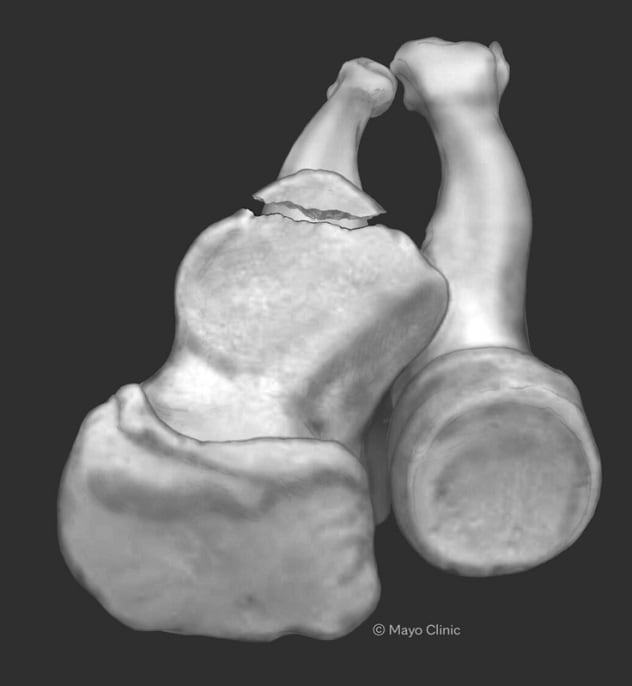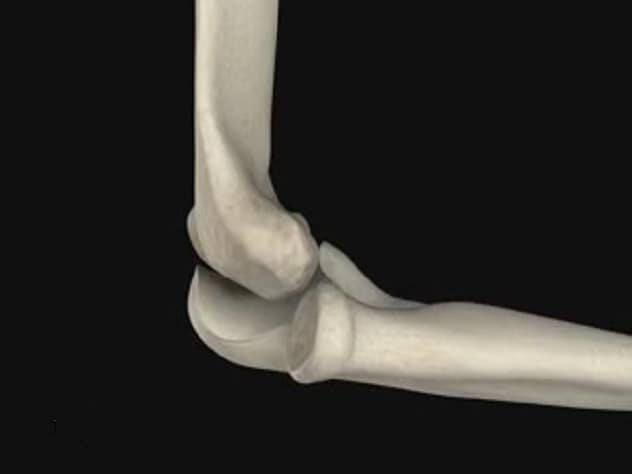Feb. 16, 2024
 Fracture patterns of the coronoid
Fracture patterns of the coronoid
An emulation of a 3D digital model of a radius and ulna depicts the fracture patterns of the coronoid.
 Elbow dislocation
Elbow dislocation
An elbow is dislocated, including external rotation of radius and ulna.
Over time, the so-called terrible triad of the elbow — coronoid and radial head fractures plus elbow dislocation — has become less terrible due to increased medical familiarity.
"The big change for terrible triad within one generation is the orthopedic community went from little to high-level understanding of this injury," says Shawn W. O'Driscoll, M.D., Ph.D., sports medicine specialist and orthopedic surgeon specializing in elbow and shoulder injuries at Mayo Clinic's campus in Minnesota.
A key contributor to misunderstanding the terrible triad was lack of knowledge about factors necessary to stabilize the complex elbow injury. Proneness to recurrent instability is inherent to the terrible triad, says Jenni Tangtiphaiboontana, M.D. Dr. Tangtiphaiboontana is an orthopedic trauma surgeon specializing in elbow and shoulder care at Mayo Clinic in Minnesota.
Yet, now orthopedic elbow specialists readily recognize this injury. Surgical repair remains complicated and merits referral to an elbow specialist.
What's in a name?
The terrible triad's name carries weight for patients, says Dr. O'Driscoll.
"When told they have an injury with a name such as terrible triad, the word 'terrible' stirs up emotional anxiety," he says.
Dr. O'Driscoll indicates the injury's name traces back to its history of misunderstanding the problem when Robert N. Hotchkiss, M.D., coined the term in the 1990s. Specifically, surgeons have considered this injury terrible due to uncertainty about fixing it well, he says.
However, surgical results are directly proportional to the surgeon's familiarity with the condition and its repair, says Dr. O'Driscoll. Due to difficulty operating on the terrible triad, he and Mayo Clinic colleagues perform numerous revision surgeries in addition to primary surgery.
The terrible triad's issues at stake
The terrible triad is a complex dislocation with severe potential life alteration without appropriate surgery, says Dr. O'Driscoll. Possible disabilities include pain and poor range of motion, leading to quality-of-life issues due to functional problems such as:
- Personal hygiene. Toothbrushing, shaving, hairstyling or applying shampoo can be difficult without a functioning elbow.
- Reaching away from the body. The original injury or inadequate surgical repair can mean patients cannot straighten their elbows and perform tasks such as making a bed, opening a car door or putting dinner in the oven.
Terrible triad surgical repair
Although the degree of fracture dictates appropriate treatment, most patients with terrible triad injuries require surgery.
Reparable radial head fractures use screws alone or plates and screws. A more severe fracture often involves radial head replacement.
Coronoid fixation depends on fracture size and location. Small avulsion fractures may not require surgery. Large fragments may be fixed with suture, screws, or plates and screws.
The surgeon also repairs ligaments and soft tissues damaged with the elbow dislocation. These injuries are typically on the lateral side of the elbow. There also may be ligament and soft tissue injuries to the medial side of the elbow. However, these often heal without further surgery, providing the elbow is stable after addressing the fracture and lateral soft tissue injuries.
If the elbow remains unstable despite adequate bony and soft tissue repair, the surgeon may place an external fixator to provide more stability. Another device that is popular recently is an internal joint stabilizer (IJS). This device functions like an external fixator and is placed under the skin. Its downside is that it requires another surgery to remove the device and can cause issues if incorrectly placed, says Dr. Tangtiphaiboontana.
Complication prevention and treatment
Terrible triad of the elbow repair requires proactively addressing complications. The most significant complication is elbow stiffness, a risk following any injury or surgery at this joint. If patients present post-surgically with elbows stiffer than expected, ulnar nerve irritation may be responsible. Patients usually complain of medial elbow pain, rather than numbness. Surgery to release or decompress the nerve may be required to facilitate better motion. Nerve irritation or damage also may lead to unnecessary bone formation, known as heterotopic ossification, which contributes to stiffness.
The body also reacts to injurious and surgical disruptions by forming scar tissue, leading to elbow stiffness, says Dr. O'Driscoll.
Prolonged post-surgical stiffness treatment success rates have improved. Mayo Clinic elbow specialists have refined arthroscopic scar tissue removal, improving elbow stiffness safely and leaving surrounding nerves intact, says Dr. O'Driscoll.
Preventing persistent elbow stiffness post-surgically is a work in progress, says Dr. O'Driscoll. A key factor in avoiding this complication is receiving definitive care within one week of injury, says Dr. Tangtiphaiboontana. Beyond rapid care, she believes therapy is crucial for patients who have had terrible triad surgery.
Terrible triad referral
Dr. O'Driscoll suggests referring patients with terrible triad injuries to a hospital with multiple orthopedic elbow specialists, such as Mayo Clinic in Minnesota.
An indicator that a patient with a terrible triad injury requires more-immediate or urgent transfer is an elbow that will not remain reduced, says Dr. Tangtiphaiboontana.
In a study with a large patient population, better results and lower complications occurred for surgeons and centers with higher terrible triad surgery volumes, says Dr. O'Driscoll.
Inadequate repair, on the other hand, can result in unhealed bone and elbow instability, says Dr. Tangtiphaiboontana. Additionally, an improperly placed radial head replacement can result in recurrent elbow instability, chronic pain and implant loosening.
Dr. O'Driscoll also says that Mayo Clinic in Minnesota is a strong contender for a terrible triad injury referral due to its history with the elbow joint. He says a significant portion of modern elbow repair history started at this institution with Bernard F. Morrey, M.D, emeritus chair of the Department of Orthopedic Surgery at Mayo Clinic in Rochester, Minnesota.
Radial head replacement surgery
The orthopedic surgeon follows these steps to replace the head of the radius.
[This animation shows the steps an orthopedic surgeon follows to replace the head of the radius. It is playing with no audio.]
For more information
Rockwood CA Jr, et al., eds. Fractures and dislocations of the elbow. In: Rockwood and Green's Fractures in Adults. 4th ed. Lippincott-Raven; 1996.
Refer a patient to Mayo Clinic.